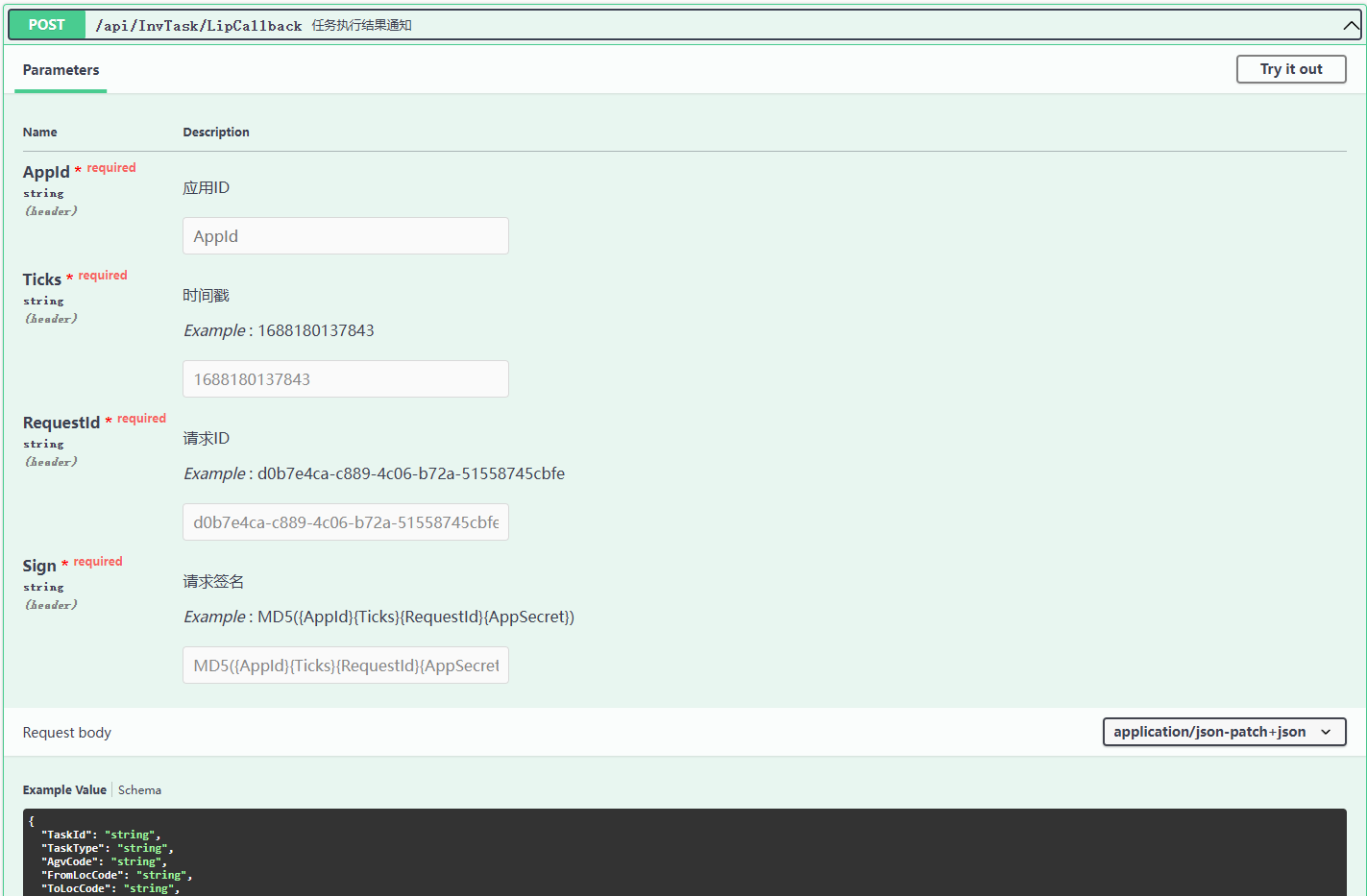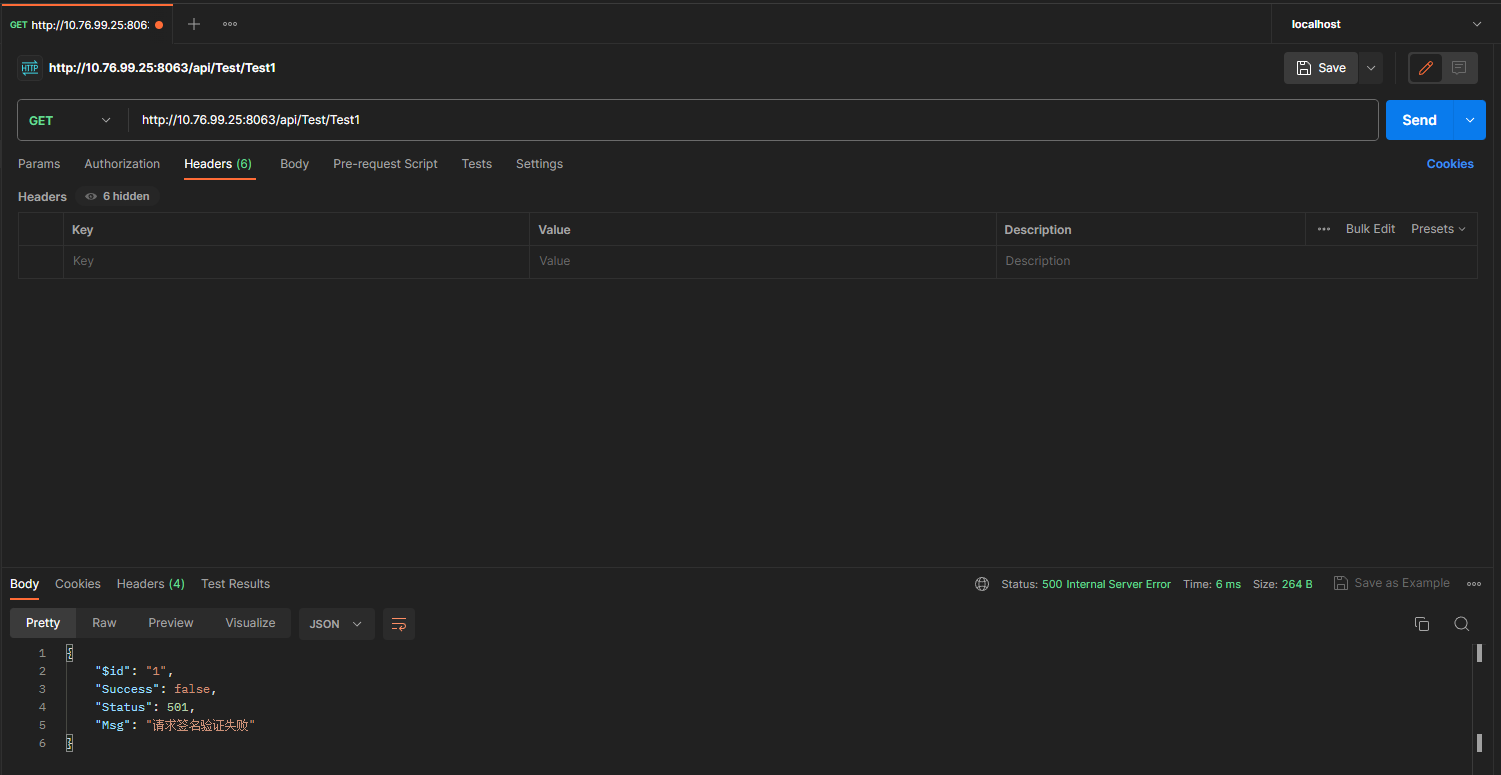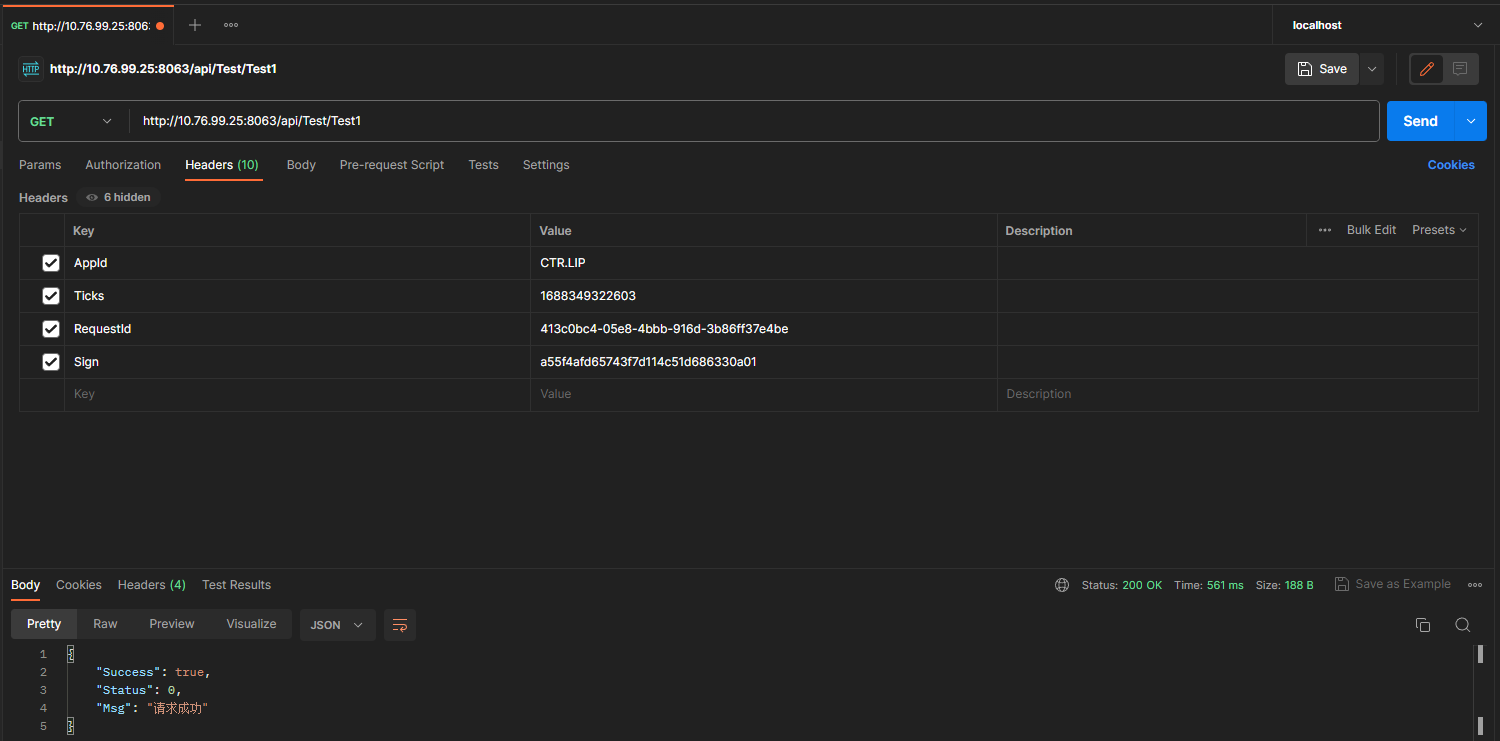WebAPI公开接口请求签名验证
前言
现在的系统后端开发的时候,会公开很多API接口
对于要登录认证后才能访问的接口,这样的请求验证就由身份认证模块完成
但是也有些接口是对外公开的,没有身份认证的接口
我们怎么保证接口的请求是合法的,有效的.
这样我们一般就是对请求的合法性做签名验证.
实现原理
为保证接口安全,每次请求必带以下header
| header名 | 类型 | 描述 |
| AppId | string | 应用Id |
| Ticks | string | 时间戳为1970年1月1日到现在时间的毫秒数(UTC时间) |
| RequestId | string | GUID字符串,作为请求唯一标志,防止重复请求 |
| Sign| string | 签名,签名算法如下 |
- 拼接字符串"{AppId}{Ticks}{RequestId}{AppSecret}"
- 把拼接后的字符串计算MD5值,此MD5值为请求Header的Sign参数传入
- 后端把对应APP配置好(AppId,AppSecret),并提供给客户端
后端验证实现
验证AppId
- 先验证AppId是不是有,没有就直接返回失败
- 如果有的话,就去缓存里取AppID对应的配置(如果缓存里没有,就去配置文件里取)
- 如果没有对应AppId的配置,说明不是正确的请求,返回失败
model.AppId = context.Request.Headers["AppId"];
if (String.IsNullOrEmpty(model.AppId))
{
await this.ResponseValidFailedAsync(context, 501);
return;
}
var cacheSvc = context.RequestServices.GetRequiredService<IMemoryCache>();
var cacheAppIdKey = $"RequestValidSign:APPID:{model.AppId}";
var curConfig = cacheSvc.GetOrCreate<AppConfigModel>(cacheAppIdKey, (e) =>
{
e.SlidingExpiration = TimeSpan.FromHours(1);
var configuration = context.RequestServices.GetRequiredService<IConfiguration>();
var listAppConfig = configuration.GetSection(AppConfigModel.ConfigSectionKey).Get<AppConfigModel[]>();
return listAppConfig.SingleOrDefault(x => x.AppId == model.AppId);
});
if (curConfig == null)
{
await this.ResponseValidFailedAsync(context, 502);
return;
}
验证时间戳
- 验证时间戳是不是有在请求头里传过来,没有就返回失败
- 验证时间戳与当前时间比较,如果不在过期时间(5分钟)之内的请求,就返回失败
- 时间戳为1970年1月1日到现在时间的毫秒数(UTC时间)
var ticksString = context.Request.Headers["Ticks"].ToString();
if (String.IsNullOrEmpty(ticksString))
{
await this.ResponseValidFailedAsync(context, 503);
return;
}
model.Ticks = long.Parse(context.Request.Headers["Ticks"].ToString());
var diffTime = DateTime.UtcNow - (new DateTime(1970, 1, 1, 0, 0, 0, DateTimeKind.Utc).AddMilliseconds(model.Ticks));
var expirTime = TimeSpan.FromSeconds(300);//过期时间
if (diffTime > expirTime)
{
await this.ResponseValidFailedAsync(context, 504);
return;
}
验证请求ID
- 验证请求ID是不是有在请求头里传过来,没有就返回失败
- 验证请求ID是不是已经在缓存里存在,如果存在就表示重复请求,那么就返回失败
- 如果请求ID在缓存中不存在,那么就表示正常的请求,同时把请求ID添加到缓存
model.RequestId = context.Request.Headers["RequestId"];
if (String.IsNullOrEmpty(model.RequestId))
{
await this.ResponseValidFailedAsync(context, 505);
return;
}
var cacheKey = $"RequestValidSign:RequestId:{model.AppId}:{model.RequestId}";
if (cacheSvc.TryGetValue(cacheKey, out _))
{
await this.ResponseValidFailedAsync(context, 506);
return;
}
else
cacheSvc.Set(cacheKey, model.RequestId, expirTime);
验证签名
1.验证签名是否正常
2.签名字符串是$"{AppId}{Ticks}{RequestId}{AppSecret}"组成
3.然后把签名字符串做MD5,再与请求传过来的Sign签名对比
4.如果一至就表示正常请求,请求通过。如果不一至,返回失败
public bool Valid()
{
var validStr = $"{AppId}{Ticks}{RequestId}{AppSecret}";
return validStr.ToMD5String() == Sign;
}
model.Sign = context.Request.Headers["Sign"];
if (!model.Valid())
{
await this.ResponseValidFailedAsync(context, 507);
return;
}
源代码
我们把所有代码写成一个Asp.Net Core的中间件
/// <summary>
/// 请求签名验证
/// </summary>
public class RequestValidSignMiddleware
{
private readonly RequestDelegate _next;
public RequestValidSignMiddleware(RequestDelegate next)
{
_next = next;
}
public async Task InvokeAsync(HttpContext context)
{
var model = new RequestValidSignModel();
//1.先验证AppId是不是有,没有就直接返回失败
//2.如果有的话,就去缓存里取AppID对应的配置(如果缓存里没有,就去配置文件里取)
//3.如果没有对应AppId的配置,说明不是正确的请求,返回失败
model.AppId = context.Request.Headers["AppId"];
if (String.IsNullOrEmpty(model.AppId))
{
await this.ResponseValidFailedAsync(context, 501);
return;
}
var cacheSvc = context.RequestServices.GetRequiredService<IMemoryCache>();
var cacheAppIdKey = $"RequestValidSign:APPID:{model.AppId}";
var curConfig = cacheSvc.GetOrCreate<AppConfigModel>(cacheAppIdKey, (e) =>
{
e.SlidingExpiration = TimeSpan.FromHours(1);
var configuration = context.RequestServices.GetRequiredService<IConfiguration>();
var listAppConfig = configuration.GetSection(AppConfigModel.ConfigSectionKey).Get<AppConfigModel[]>();
return listAppConfig.SingleOrDefault(x => x.AppId == model.AppId);
});
if (curConfig == null)
{
await this.ResponseValidFailedAsync(context, 502);
return;
}
//1.把缓存/配置里面的APP配置取出来,拿到AppSecret
//2.如果请求里附带了AppSecret(调试用),那么就只验证AppSecret是否正确
//3.传过来的AppSecret必需是Base64编码后的
//4.然后比对传过来的AppSecret是否与配置的AppSecret一至,如果一至就通过,不一至就返回失败
//5.如果请求里没有附带AppSecret,那么走其它验证逻辑.
model.AppSecret = curConfig.AppSecret;
var headerSecret = context.Request.Headers["AppSecret"].ToString();
if (!String.IsNullOrEmpty(headerSecret))
{
var secretBuffer = new byte[1024];
var secretIsBase64 = Convert.TryFromBase64String(headerSecret, new Span<byte>(secretBuffer), out var bytesWritten);
if (secretIsBase64 && Encoding.UTF8.GetString(secretBuffer, 0, bytesWritten) == curConfig.AppSecret)
await _next(context);
else
{
await this.ResponseValidFailedAsync(context, 508);
return;
}
}
else
{
//1.验证时间戳是不是有在请求头里传过来,没有就返回失败
//2.验证时间戳与当前时间比较,如果不在过期时间(5分钟)之内的请求,就返回失败
//时间戳为1970年1月1日到现在时间的毫秒数(UTC时间)
var ticksString = context.Request.Headers["Ticks"].ToString();
if (String.IsNullOrEmpty(ticksString))
{
await this.ResponseValidFailedAsync(context, 503);
return;
}
model.Ticks = long.Parse(context.Request.Headers["Ticks"].ToString());
var diffTime = DateTime.UtcNow - (new DateTime(1970, 1, 1, 0, 0, 0, DateTimeKind.Utc).AddMilliseconds(model.Ticks));
var expirTime = TimeSpan.FromSeconds(300);//过期时间
if (diffTime > expirTime)
{
await this.ResponseValidFailedAsync(context, 504);
return;
}
//1.验证请求ID是不是有在请求头里传过来,没有就返回失败
//2.验证请求ID是不是已经在缓存里存在,如果存在就表示重复请求,那么就返回失败
//3.如果请求ID在缓存中不存在,那么就表示正常的请求,同时把请求ID添加到缓存
model.RequestId = context.Request.Headers["RequestId"];
if (String.IsNullOrEmpty(model.RequestId))
{
await this.ResponseValidFailedAsync(context, 505);
return;
}
var cacheKey = $"RequestValidSign:RequestId:{model.AppId}:{model.RequestId}";
if (cacheSvc.TryGetValue(cacheKey, out _))
{
await this.ResponseValidFailedAsync(context, 506);
return;
}
else
cacheSvc.Set(cacheKey, model.RequestId, expirTime);
//1.验证签名是否正常
//2.签名字符串是$"{AppId}{Ticks}{RequestId}{AppSecret}"组成
//3.然后把签名字符串做MD5,再与请求传过来的Sign签名对比
//4.如果一至就表示正常请求,请求通过。如果不一至,返回失败
model.Sign = context.Request.Headers["Sign"];
if (!model.Valid())
{
await this.ResponseValidFailedAsync(context, 507);
return;
}
await _next(context);
}
}
/// <summary>
/// 返回验证失败
/// </summary>
/// <param name="context"></param>
/// <param name="status"></param>
/// <returns></returns>
public async Task ResponseValidFailedAsync(HttpContext context, int status)
{
context.Response.StatusCode = 500;
await context.Response.WriteAsJsonAsync(new ComResult() { Success = false, Status = status, Msg = "请求签名验证失败" }, Extention.DefaultJsonSerializerOptions, context.RequestAborted);
}
}
public class AppConfigModel
{
public const string ConfigSectionKey = "AppConfig";
/// <summary>
/// 应用Id
/// </summary>
public string AppId { get; set; }
/// <summary>
/// 应用密钥
/// </summary>
public string AppSecret { get; set; }
}
public class RequestValidSignModel : AppConfigModel
{
/// <summary>
/// 前端时间戳
/// Date.now()
/// 1970 年 1 月 1 日 00:00:00 (UTC) 到当前时间的毫秒数
/// </summary>
public long Ticks { get; set; }
/// <summary>
/// 请求ID
/// </summary>
public string RequestId { get; set; }
/// <summary>
/// 签名
/// </summary>
public string Sign { get; set; }
public bool Valid()
{
var validStr = $"{AppId}{Ticks}{RequestId}{AppSecret}";
return validStr.ToMD5String() == Sign;
}
}
中间件注册扩展
写一个中间件的扩展,这样我们在Program里可以方便的使用/停用中间件
/// <summary>
/// 中间件注册扩展
/// </summary>
public static class RequestValidSignMiddlewareExtensions
{
public static IApplicationBuilder UseRequestValidSign(this IApplicationBuilder builder)
{
return builder.UseMiddleware<RequestValidSignMiddleware>();
}
}
///Program.cs
app.UseRequestValidSign();
与Swagger结合
我们一般对外提供在线的Swagger文档
如果我们增加了请求验证的Header,那么所有接口文档里面都要把验证的Header添加到在线文档里面
/// <summary>
/// 请求签名验证添加Swagger请求头
/// </summary>
public class RequestValidSignSwaggerOperationFilter : IOperationFilter
{
public void Apply(OpenApiOperation operation, OperationFilterContext context)
{
if (operation.Parameters == null)
operation.Parameters = new List<OpenApiParameter>();
operation.Parameters.Add(new OpenApiParameter
{
Name = "AppId",
In = ParameterLocation.Header,
Required = true,
Description = "应用ID",
Schema = new OpenApiSchema
{
Type = "string"
}
});
operation.Parameters.Add(new OpenApiParameter
{
Name = "Ticks",
In = ParameterLocation.Header,
Required = true,
Description = "时间戳",
Example = new OpenApiString(((long)(DateTime.UtcNow - new DateTime(1970, 1, 1, 0, 0, 0, DateTimeKind.Utc)).TotalMilliseconds).ToString()),
Schema = new OpenApiSchema
{
Type = "string"
}
});
operation.Parameters.Add(new OpenApiParameter
{
Name = "RequestId",
In = ParameterLocation.Header,
Required = true,
Description = "请求ID",
Example = new OpenApiString(Guid.NewGuid().ToString()),
Schema = new OpenApiSchema
{
Type = "string"
}
});
operation.Parameters.Add(new OpenApiParameter
{
Name = "Sign",
In = ParameterLocation.Header,
Required = true,
Description = "请求签名",
//{AppId}{Ticks}{RequestId}{AppSecret}
Example = new OpenApiString("MD5({AppId}{Ticks}{RequestId}{AppSecret})"),
Schema = new OpenApiSchema
{
Type = "string"
}
});
operation.Parameters.Add(new OpenApiParameter
{
Name = "AppSecret",
In = ParameterLocation.Header,
Description = "应用密钥(调试用)",
Example = new OpenApiString("BASE64({AppSecret})"),
Schema = new OpenApiSchema
{
Type = "string"
}
});
}
}
///在Program.cs里添加Swagger请求验证Header
builder.Services.AddSwaggerGen(c =>
{
c.OperationFilter<RequestValidSignSwaggerOperationFilter>();
});

客户端调用实现
我们如果用HttpClient调用的话,就要在调用请求前
设置后请求头,AppId,Ticks,RequestId,Sign
public async Task<string> GetIPAsync(CancellationToken token)
{
this.SetSignHeader();
var result = await Client.GetStringAsync("/Get", token);
return result;
}
public void SetSignHeader()
{
this.Client.DefaultRequestHeaders.Clear();
var ticks = ((long)(DateTime.UtcNow - new DateTime(1970, 1, 1, 0, 0, 0, DateTimeKind.Utc)).TotalMilliseconds).ToString();
var requestId = Guid.NewGuid().ToString();
var signString = $"{this.Config.AppId}{ticks}{requestId}{this.Config.AppSecret}";
var sign = this.GetMD5(signString);
this.Client.DefaultRequestHeaders.Add("AppId", this.Config.AppId);
this.Client.DefaultRequestHeaders.Add("Ticks", ticks);
this.Client.DefaultRequestHeaders.Add("RequestId", requestId);
this.Client.DefaultRequestHeaders.Add("Sign", sign);
}
public string GetMD5(string value)
{
using (MD5 md5 = MD5.Create())
{
byte[] inputBytes = Encoding.UTF8.GetBytes(value);
byte[] hashBytes = md5.ComputeHash(inputBytes);
StringBuilder sb = new StringBuilder();
for (int i = 0; i < hashBytes.Length; i++)
{
sb.Append(hashBytes[i].ToString("x2"));
}
return sb.ToString();
}
}
最终效果
当我们没有传签名参数的时候,返回失败

当我们把签名参数都传正确后,返回正确

都看完了,你确定不点个赞再走?



